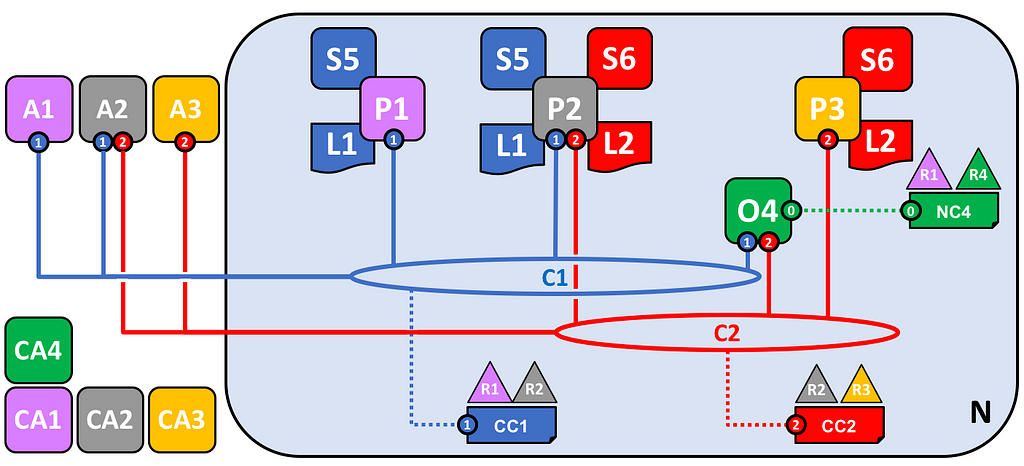Latest news about Bitcoin and all cryptocurrencies. Your daily crypto news habit.
Hyperledger Fabric — the 20 most important terms made simple
Your cheatsheet for understanding some awesome tech
I took a couple of days to sit down and read the docs for Hyperledger Fabric. Spoiler alert it’s awesome tech.
The Private Data Collections addresses how to use private data in smart contracts.
 Hyperledger Fabric network components. A1 is an application. P1 is a peer node. S5 is a smart contract. L1 is a ledger. C1 is a channel. CA1 is a certificate authority. NC4 is a network configuration. R1 is an organisation. CC1 is a channel configuration.O4 is a ordering service. N is the Hyperledger network. image source
Hyperledger Fabric network components. A1 is an application. P1 is a peer node. S5 is a smart contract. L1 is a ledger. C1 is a channel. CA1 is a certificate authority. NC4 is a network configuration. R1 is an organisation. CC1 is a channel configuration.O4 is a ordering service. N is the Hyperledger network. image source
If I was a gambling man, which I am, my money is on them for enterprise adoption.
Below is an explanation of the key terms.
Anchor Peer
This gets used for communications between organisations. It makes peers in different organisations aware of each other.
Blocks
Consist of a header, block data (transactions) and block metadata (information about nodes involved with creating the block).
Certificate Authorities
Everyone who wants to interact with the networks needs an identity. The CA provides the means for each actor to have a verifiable digital identity. Hyperledger Fabric has a built in CA component for use in the blockchain network.
Chaincode
The Hyperledger Fabric term for a smart contract. Note that chaincode does not have to be installed on every peer in a channel.
Channel
A channel allows a group of participants to create a separate ledger of transactions. The transactions are only visible to the members of the channel.
Channel Configuration
Rules that govern the channel, the channel is governed by the channel members. The channel configuration is separate from the network configuration.
Consortium
A group of organisations that share a need to transact.
Committing Peer
Every peer in the channel.
Endorsing Peer
Every peer that has the smart contract installed can be an endorsing peer.
Endorsement Policy
The rules for which organisations much approve a transaction before the other organisations will accept a copy. This is part of the channel configuration.
Leader Peer
An organization can have multiple peers in a channel. Only one peer from the organization needs to receive the transactions. The leader distributes transactions from the orderer.
Membership Service Provider
Is a trusted authority.
The MSP identifies which Root Certificate Authorities (CA) and Intermediate CA’s are trusted by the network. The MSP identifies what roles different actors in an organization can play in the network.
Nodes join the network through a Membership Service Provider.
Ledger
This is an append only file while can be used to recreate the world state.
Ordering Nodes
Is like a network administration point. The ordering nodes support the application channels for ordering transactions into blocks.
Peer Nodes
Each peer maintains a copy of the ledger for each channel it is a member of.
Policies
These determine who has control over the network configuration.
Private Data Collection
This is used for keeping the data in a transaction confidential. The data is stored in a private database that is separated from the channel ledger.
Public Key Infrastructure
This provides secure communication in a network. CAs issue digital certificates that get used to authenticate messages in the network. The PKI provides a list of identities and the MSP says which of them are part of an organization.
System Chaincode
Is code that defines operating parameters for the entire channel.
Lifecycle and configuration system chaincode defines the rules for the channel. Endorsement and validation system chaincode defines the requirements for endorsing and validating transactions.
World State
Is a snapshot of the current state of the objects in the network, this is usually a graph database in practise.
Hyperledger Fabric — the 20 most important terms made simple was originally published in Hacker Noon on Medium, where people are continuing the conversation by highlighting and responding to this story.
Disclaimer
The views and opinions expressed in this article are solely those of the authors and do not reflect the views of Bitcoin Insider. Every investment and trading move involves risk - this is especially true for cryptocurrencies given their volatility. We strongly advise our readers to conduct their own research when making a decision.